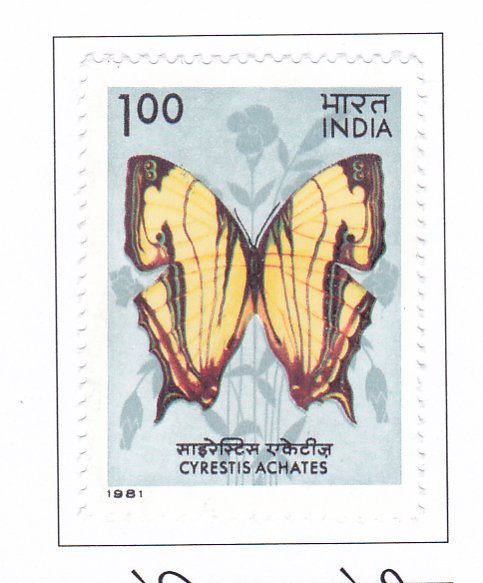Cyrestis achates – Map Butterfly

Technical Data
| Stamp Set | Butterflies |
|---|---|
| Date of Issue | October 20, 1981 |
| Denomination | Rs. 1 |
| Quantity | 2,000,000 |
| Perforation | comb 13 |
| Printer | Security Printing Press, Nashik |
| Watermark | No Watermark |
| Colors | Multicolor |
| Catalog Codes |
Michel IN 884 Stamp Number IN 937 Yvert et Tellier IN 683 Stanley Gibbons IN 1021 |
| Themes | Animals (Fauna) | Butterflies and Moths | Insects |
Butterflies and moths, belonging to the order Lepidoptera, have a rich history dating back to the Cretaceous period, around 135 million years ago. With approximately 220 thousand species, including nearly 45 thousand butterflies, they are among the most diverse insects on Earth. Tropics, with their lush forests and vibrant flowers, host the richest variety of butterflies.
Despite their delicate appearance, butterflies possess survival strategies such as protective resemblance and mimicry. The kallima butterfly, for example, resembles a decayed leaf when at rest, while the Viceroy butterfly mimics the inedible Monarch to evade predators.
Their sublime beauty has inspired poets and artists across cultures, but many species are now threatened with extinction due to habitat destruction. To raise awareness, stamps featuring endemic butterfly species from the Indian Subcontinent have been issued.
One such species is Cyrestis achates, known as the “map” butterfly for its wing markings resembling lines of latitude and longitude. It lays eggs on the underside of banyan leaves, where the larvae feed in groups.
In addition to Cyrestis achates, stamps also depict other endemic species such as Stichophthalma camadeva, Cethosia biblis, and Teinopalpus imperialis, showcasing the diverse and exquisite beauty of butterflies in the Indian Subcontinent.
